I am solving a system of PDEs using Fipy which involve two parameters or constants, so I would like to know whether is also possible to estimate those parameters in Fipy, or what others libraries would be more adequate for that.
Note: I know that scipy has some functions for that (optimize.minimize for MLE), but I am not sure if is adequate apply them to a code of Fipy.
UPDATE: For the below PDE system I want to estimate the two unknown parameters: "Beta" and "m"

The function for solving this PDE in Fipy would be something like that:
import scipy as sci
import fipy as fipy
import numpy as np
from fipy import *
# Grid
nx = 100
ny = 100
dx = 1.
dy = dx
mesh = Grid2D(nx=nx, ny=ny, dx=dx, dy=dy)
x = mesh.cellCenters[0]
y = mesh.cellCenters[1]
# Setting variable of results and adding inicial conditions
u = CellVariable(name="Individual 1", mesh=mesh, value=0.)
u.setValue(1., where=(50. < x) & (70. > x) & (50. < y) & (70. > y))
v = CellVariable(name="Individual 2", mesh=mesh, value=0.)
v.setValue(1., where=(40. < x) & (60. > x) & (40. < y) & (60. > y))
p = CellVariable(name= "Marks Individual 1", mesh=mesh, value=0.)
p.setValue(1., where=(50. < x) & (70. > x) & (50. < y) & (70. > y))
q = CellVariable(name= "Marks Individual 2", mesh=mesh, value=0.)
q.setValue(1., where=(40. < x) & (60. > x) & (40. < y) & (60. > y))
# Plotting inicial conditions
if __name__ == '__main__':
viewer = Viewer(u, v, datamin=0., datamax=1.)
viewer.plot()
# Setting PDE
def HRMLE(params):
m = params[0]
beta = params[1]
D = 1.
CU = CellVariable(mesh=mesh, rank=1)
CU[:]= 1.
CU.setValue(-1., where = (x > 60.) * [[[1], [0]]])
CU.setValue(-1., where = (y > 60.) * [[[0], [1]]])
CV = CellVariable(mesh=mesh, rank=1)
CV[:]=1.
CV.setValue(-1., where = (x > 50.) * [[[1], [0]]])
CV.setValue(-1., where = (y > 50.) * [[[0], [1]]])
# Transient formulation
eqU = TransientTerm() == DiffusionTerm(coeff=D) -\
ConvectionTerm(coeff=CU*q.value*beta)
eqV = TransientTerm() == DiffusionTerm(coeff=D) -\
ConvectionTerm(coeff=CV*p.value*beta)
eqP = TransientTerm() == u*(1 + m*q) - p
eqQ = TransientTerm() == v*(1 + m*p) - q
# Solving Transient term
timeStepDuration = 1.
steps = 50
t = timeStepDuration * steps
for step in range(steps):
eqU.solve(var=u, dt=timeStepDuration)
eqV.solve(var=v, dt=timeStepDuration)
eqP.solve(var=p, dt=timeStepDuration)
eqQ.solve(var=q, dt=timeStepDuration)
# Plotting results
#if __name__ == '__main__':
# vieweru = Viewer(u, datamin=0., datamax=1.)
# viewerv = Viewer(v, datamin=0., datamax=1.)
# vieweru.plot()
# viewerv.plot()
loglink = np.sum(np.log(u.value)) + np.sum(np.log(v.value))
return(loglink)
Finally, for Maximun likelihood criteria I would like to maximise:

Setting an initial value, and using scipy
mb = [0., .5]
mb
results = sci.optimize.minimize(HRMLE, mb, method='Nelder-Mead')
results
The results show values that always are close to my initial values for the parameters, that's the reason I am not sure the my procedure is right. Any suggestions will be quite appreciated.